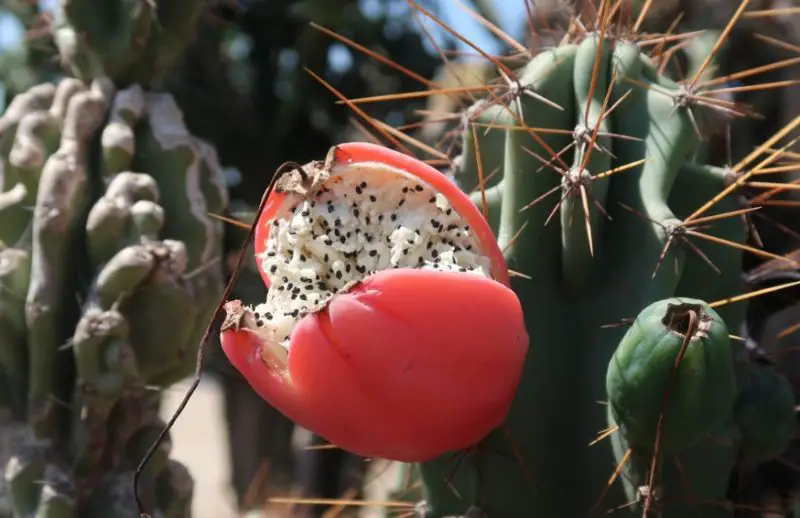The Peruvian apple cactus, known scientifically as Cereus peruvianus, Cereus Uruguayanus, or Cereus Repandus, is a stunning, columnar cactus that stands out in gardens and homes alike. Characterized by its thick, cylindrical stems and dramatic white, night-blooming flowers, this cactus offers both beauty and functionality.
Despite its name, the plant is native to regions such as Brazil, Uruguay, Argentina, and Paraguay, not Peru. Its ability to thrive in arid, desert-like conditions makes it a popular choice for gardeners in regions like Florida, Arizona, Southern California, and beyond.
In this detailed care guide, we’ll cover everything you need to know about growing and caring for the Peruvian apple cactus, from planting and propagation to pest control and pruning.
Appearance and Features of the Peruvian Apple Cactus

The Peruvian apple cactus is a visually striking plant that can reach impressive heights. In its natural habitat, the cactus can grow up to 30 feet tall, but when cultivated indoors, it usually maxes out around 5-6 feet. Its bluish-green stems are ribbed with prominent thorns and spines that can vary from brown to yellow, depending on the variety.
One of the most captivating features of the Peruvian apple cactus is its night-blooming flowers. These flowers, often referred to as “Queen of the Night” or “Princess of the Night,” are large, fragrant, and can reach up to 7 inches in diameter. They typically open at dusk or early morning and last only for a few hours before wilting. The cactus also produces a delicious, edible fruit known as the Peruvian apple or pitaya, which is similar to dragon fruit and packed with nutrients.
Using Peruvian Apple Cactus in Your Garden
With its towering, columnar structure, the Peruvian apple cactus can serve as an excellent focal point in any garden. Its height and bold appearance make it perfect for planting in rock gardens or xeriscapes, especially in regions where drought-tolerant plants thrive. For a harmonious garden design, pair it with other hardy plants such as Mountain Pepper (Drimys lanceolata), a shrub that can reach up to 13 feet, or other succulents that have similar water and light requirements.
When planting outdoors, ensure your cactus receives full sun, as it needs at least eight hours of sunlight to grow optimally. If your goal is to promote flower and fruit production, consider planting multiple cacti together. Group planting encourages a higher yield of both blooms and fruits.
Ideal Garden Companions
- Mountain Pepper (Drimys lanceolata)
- Other drought-tolerant succulents and shrubs
- Ornamental grasses and rock plants
How to Grow and Propagate Peruvian Apple Cactus
There are two primary methods to propagate the Peruvian apple cactus: through offsets (pups) or seeds. However, growing from offsets is far more efficient due to the cactus’s slow growth rate.
Propagation by Offsets
Offsets are small pups that grow from the base of the mother plant. Here’s how to propagate them:
- Use a sharp, sterile knife to carefully cut the offset from the base.
- Remove excess soil and allow the cutting to callus for a few days. This reduces the risk of fungal infection.
- Once callused, plant the offset in a well-draining, peat-based compost.
- Water sparingly until the cactus establishes roots.
Propagation by Seeds
Growing the Peruvian apple cactus from seeds is possible, but it’s a slow process. For those who prefer this method, ensure outdoor temperatures range between 70-80°F for optimal growth. When seeding, avoid direct sunlight, as young seedlings are sensitive.
Regardless of the propagation method, the key to healthy growth is well-draining soil. You can enhance the drainage by adding perlite or coarse sand to your soil mix.
Growth Rate and Maintenance
The Peruvian apple cactus is a slow grower, averaging just 2-4 feet of growth per year under ideal conditions. To encourage faster growth, make sure the cactus is planted in a sunny location and that you rotate it regularly to ensure even growth. If you’re growing the cactus indoors, it will eventually need a taller pot to accommodate its expanding root system and height.
Key Tips for Faster Growth:
- Fertilize in spring with a cactus-specific fertilizer high in potassium, nitrogen, and phosphorus.
- Rotate regularly to ensure even exposure to sunlight.
- Use a well-draining soil mix and avoid overwatering, especially in winter.
Flowering and Fruiting of the Peruvian Apple Cactus
The Peruvian apple cactus typically blooms in late spring and early fall. These fragrant flowers, which open at dusk and close before sunrise, are a sight to behold. However, their brief lifespan means you’ll need to be vigilant to catch them in full bloom. Once pollinated, the cactus produces Peruvian apple fruits, which are edible and packed with nutrients.
Pollination Tips:
If your cactus is grown indoors, you may need to hand-pollinate the flowers using a small paintbrush. Simply transfer pollen from one flower to another to encourage fruit development.
Caring for the Peruvian Apple Cactus
The Peruvian apple cactus is relatively low-maintenance but requires the right conditions to thrive. Whether planted outdoors or indoors, follow these care guidelines to ensure a healthy and vibrant cactus.
Light Requirements
Provide the cactus with a minimum of 8 hours of direct sunlight daily. If grown indoors, place it near a sunny, south-facing window.
Watering
During the growing season (spring and summer), water the cactus thoroughly but allow the soil to dry out completely between waterings. In the dormant winter months, reduce watering significantly to prevent root rot.
Pruning
Occasionally pruning is necessary to remove damaged or diseased stems. Wear protective gloves and goggles when handling the cactus, as its spines can be quite sharp.
Common Pests
Although relatively pest-resistant, the Peruvian apple cactus can occasionally suffer from infestations of spider mites, aphids, or mealybugs. Use organic insecticides or rubbing alcohol to treat the affected areas.
Repotting the Peruvian Apple Cactus
Young Peruvian apple cacti will need to be repotted every 1-2 years, while mature plants can remain in the same pot for several years. Repotting should be done in the spring, using a sturdy, well-draining container. When repotting, add gravel or stones to the bottom of the pot to improve drainage and prevent root rot.
Protecting the Cactus in Cold Weather
The Peruvian apple cactus is hardy in USDA zones 9-11 and can withstand temperatures as low as 18°F. However, if temperatures are expected to drop below this, consider covering the cactus with burlap or moving it indoors. For outdoor cacti, styrofoam cups can be placed over the growing tips for added protection during cold spells.
Conclusion
The Peruvian apple cactus is an impressive and versatile plant that adds a touch of the exotic to any garden or home. With its striking appearance, edible fruit, and night-blooming flowers, this cactus is sure to captivate gardeners and plant enthusiasts alike. By following the guidelines outlined in this article, you can ensure your cactus thrives and becomes a stunning addition to your plant collection.
Whether you’re growing it outdoors in a garden or indoors as a decorative centerpiece, the Peruvian apple cactus is a resilient, low-maintenance plant that rewards proper care with striking beauty and tasty fruit.







My P.A.C. HAS GROWN TO TALL FOR ITS WINTER HOME. I WOULD LIKE TO TAKE 12” TOP. WHAT ARE YOUR THOUGHTS ON CUTTING THE TOP.